Planning and development in Detroit
Planning and development in Detroit since the late 20th century has attempted to enhance the economy and quality of life of Detroit, Michigan, United States. In 1970, the private group Detroit Renaissance began to facilitate development in the city. Its successor, Business Leaders for Michigan, has continued to facilitate development into the 21st century. Projects have included new commercial facilities, revitalization of neighborhoods, hospitality infrastructure, and improvements to recreational and public facilities, such as the QLine light rail project.
History
[edit]
In 1970, Henry Ford II conceived of the Renaissance Center as a way to help the city retain residents who were moving to the suburbs. The group announced the first phase of construction in 1971. Detroit Mayor Roman Gribbs touted the project as part of "a complete rebuilding from bridge to bridge," referring to the area between the Ambassador Bridge that connected Detroit to Windsor, Ontario and the MacArthur Bridge, which connects the city with Belle Isle Park. He presented architectural renderings of "linked riverfront parks" from Renaissance Center to MacArthur Bridge, like a necklace, for public access.
The first Renaissance Center tower opened on July 1, 1976.[1] Architects' initial design for the Renaissance Center focused on creating secure interior spaces, while its design later expanded to connect with the exterior spaces and waterfront through a reconfigured interior, open glass entryways, and a Wintergarden.[2][3]
Late in 1973, Detroit elected its first African-American mayor, Coleman Young. During his administration, major developments completed included a combination of residential, retail, business, and retail projects: Renaissance Center, the Joe Louis Arena, the Detroit People Mover, the General Motors Detroit/Hamtramck Assembly Plant, Detroit Receiving Hospital, the Chrysler Jefferson North Assembly Plant, the Riverfront Condominiums, the Millender Center Apartments, Harbortown, 150 West Jefferson, One Detroit Center and restoration of the Fox Theatre.
Dennis Archer, a former Michigan Supreme Court Justice and mayor in the mid-to-late 1990s, supported a plan to add casinos as a catalyst for development in Detroit. Initially, his plan was for a casino cluster along the east riverfront.[4] Ultimately, three large hotels with attached casinos were constructed in or near Detroit's downtown area: the Greektown Casino Hotel, the MGM Grand Detroit, and the Motor City Casino. In 2007, USA Today reported that the State of Michigan received more than $8.3 million yearly from Detroit's three casinos, and that in 2006 Detroit ranked fifth in U.S. casino markets with $1.3 billion in annual revenue.[5] Archer also championed the construction of two new sports stadiums, Ford Field for the Detroit Lions and Comerica Park for the Detroit Tigers.

In June 2007, the Detroit Riverfront Conservancy, a 501(c)(3) organization, celebrated the first significant opening of new public space on the Detroit International Riverfront since its inception in early 2003.[6][7] It has raised hundreds of millions of dollars to develop and manage Detroit's riverfront. The International Riverfront area ranges from the Ambassador Bridge to Belle Isle in downtown Detroit, encompassing a multitude of parks, restaurants, retail shops, skyscrapers, and high-rise residential areas along the Detroit River.
In 2009, Detroit Renaissance expanded its mission to address the need for regional economic development;[8] the successor organization, Business Leaders for Michigan, is a group that gives thousands of dollars to Republican political campaigns.[9] It is devoted to the creation of the Newt Gingrich-supported Michigan Turnaround Plan.[10][11] Other participants in area revitalization efforts include the Detroit Riverfront Conservancy,[12] the Detroit Economic Club, the Detroit Club, Cityscape Detroit, universities in the Detroit region, and the Michigan Economic Development Corporation, which has offices in the Cadillac Place state office complex in the city's New Center area.
In recognition of the city's architecture and historic significance, many of the city's buildings and districts have been listed on the National Register of Historic Places. They are eligible for federal historic tax credits for development.[13][14] State tax historic tax credits are also available for qualified historic preservation.[15][16]
Initiatives
[edit]Some of Detroit's successful revitalizations include the New Center, Lafayette Park, East Ferry Avenue Historic District, Campus Martius, Grand Circus Park Historic District, and Washington Boulevard Historic District. In 2002, a major renovation of the historic Cadillac Place consolidated state offices from around the area into the city's New Center area. In 2003, General Motors completed a $500 million redevelopment of the Renaissance Center as its world headquarters.[17]
The east riverfront promenade development for the Detroit International Riverfront was planned at $559 million, including $135 million from GM and $50 million from the Kresge Foundation.[18] The city has completed major redevelopment of Campus Martius Park and Cadillac Square Park. The plans have produced new downtown stadiums and a rebuilt freeway system intended to showcase the city for Super Bowl XL. With $1.6 billion in construction projects in 2004, the rapid pace of development in the city prompted construction of a $30 million cement terminal.[19] In 2007, Bank of America announced that it would commit $25 billion to community development in Michigan following its acquisition of LaSalle Bank in Troy.[20]
For 2010, the domestic automakers reported significant profits, indicating the beginning of rebound.[21][22][23] Between 2009 and 2010, Detroit ranked seventh in the nation for economic recovery.[24] A study conducted in 2006 by the University of Michigan-Dearborn determined that, in addition to the roughly 18,000 employees at the Detroit Metropolitan Wayne County Airport, activity had generated an additional 14,500 jobs in Wayne County and another 70,000 statewide,[25] primarily through firms such as hotels, restaurants, and rental car agencies. The study made the assumption that passenger traffic through the airport and economic activity in these service industries would increase on a 1:1 ratio.
The Wayne County Airport Authority saw the potential for growth in the air transportation sector almost a decade ago,[when?] and began a capital improvement plan for the airport. The three original terminals from the 1950s were replaced by two new state-of-the-art terminals that opened in 2002 and 2008, respectively. Other major infrastructure improvements have been made to the runways, cargo facilities, and the terminals themselves, with an eye toward increasing the airport's capacity. At the time, the FAA forecasted a 15.2% growth in passenger travel from 2005 to 2010, and another 12.8% increase from 2010 to 2015. It was projected that the construction projects themselves would create 4,470 jobs, with an additional 21,500 jobs statewide due to increased passenger traffic.[26]
One major focus of the capital improvement plan was to enhance Detroit's international gateway. Total travel has grown due to a surge in international travel, and international flights continued to increase before the recession negatively affected such flights at many airports.[27]
Some other economic development initiatives in Detroit include the following:
- The Detroit Office of Targeted Business Development is also working to "utilize the City's enormous buying power to re-circulate Detroit dollars within the local economy as many times as possible and to work collaboratively with other City agencies such as the Mayor's Office of Neighborhood Commercial Revitalization (ONCR), with the ultimate goal of building and sustaining both the commercial infrastructure and the residential neighborhoods, thus transforming the Next Detroit." This includes facilitating the startup and growth of Detroit-based, women-owned businesses; Detroit-based minority-owned businesses; and Detroit-based small businesses.[28]
- The Michigan Small Business Technology Development Center works to strengthen companies, create new jobs, retain existing jobs, and assist companies in defining their path to success.[29]
- The Detroit Economic Growth Corporation (DEGC) manages major economic development initiatives on behalf of the City of Detroit, including transforming the East Riverfront District, developing the I-94 Industrial Park, managing the Lower Woodward Improvement Program, and creating the Paradise Valley Cultural and Entertainment District. The DEGC also provides staff services to Detroit's public development authorities.[30]
- The City of Detroit Downtown Development Authority supports private investments and business growth within Detroit's central business district with loans, sponsorships and grants, capital improvements to public infrastructure, and other programs that increase economic activity.[30]
- The Detroit Brownfield Redevelopment Authority (DBRA) to promote revitalization of environmental clean-up areas within the boundaries of the City of Detroit. The DBRA has approved over 160 brownfield plans, which are expected create $6 billion in new investments, 13,000 jobs, and over 9,000 housing units.[30]
- The Economic Development Corporation of the City of Detroit assists local industrial and commercial enterprises to strengthen and revitalize the city and state economy through a loan program, public infrastructure improvements, and other programs.[30]
- The Office of Neighborhood Commercial Revitalization (ONCR) has created a system of support services and strategies to targeted commercial strips, incorporating technical assistance and training, grants, and loans to address local business development. Some programs from the ONCR include Re$tore Detroit, ReFresh Detroit, and Small Business Detroit! Microloan, all of which provide financial support and assistance.[31]
- The Michigan Works! System is the first unified workforce development system in the country and an instrumental partner for developing Michigan's economic future. The system comprises twenty-five agencies that focus on innovative, proactive solutions to meet the demands of a rapidly changing economy.[32]
Some experts believe that Detroit needs to utilize the region's rich automotive history to break into new industries, such as battery technology, hybrid vehicles,[33] and the auto parts industry, along with auto assembly.[34] Other experts believe that Detroit's geographic location next to Canada provides a unique opportunity for trade and organizational growth. For example, Detroit's Wayne State University and the University of Windsor, Canada host an annual business symposium in order to tap into this strategic advantage and expand cross-border partnerships between Detroit and the Windsor region.[35]
Quality of life initiatives, including the revitalization of parks, residential units, new construction, and historic renovations are at the forefront of the city's plan to accelerate redevelopment across the city. For instance, in 2004, the city added hundreds of new residential units to its downtown area.[36] From 2000 to 2007, the city saw continuous annual increases in tax revenues from its casinos with the city estimated to collect $178.25 million in casino taxes alone for 2007, with the casino resorts opening in 2008.[37]
Urban infrastructure
[edit]In October 2013, approval was given to John Hantz, a successful financial consultant in Detroit, who is devoting $30 million of his own funding to create Hantz Farms, a commercial urban forestry initiative; Hantz Woodlands, an urban tree farm project; and redevelopment of a blighted Detroit residential area covering nearly 180 acres on the city's east side. The Hantz project area is bordered by Van Dyke on the west, St. Jean on the east, Mack Avenue on the north and Jefferson on the south.[38][39][40]
On December 6, 2013, bankruptcy judge Steven Rhodes approved a $210 million financing arrangement for overhauling the city's antiquated lighting system.
On December 13, 2013, the Public Lighting Authority (PLA) completed the initial sale of $60 million in bonds, part of a $210 million, two-step bond issue, to finance the purchase of up to 50,000 LED street lights. The new 150 watt LED lights are longer-lasting, are more than twice as bright as the old 70 Watt sodium lights, and are more affordable to operate. The goal was to have the installation completed in all neighborhoods by the end of 2015, and underground wiring of the thoroughfares done by the end of 2016. [41][42]
On June 12, 2014, Detroit's Public Lighting Authority, created to take up fixing nonworking streetlights throughout the city, said that it would borrow $185 million in bonds, $20 million more than it initially had planned, after Standard & Poor's graded the agency's credit risk as relatively low, and compared with that of the bankrupt city. The sale of these bonds means an additional 15,00 lights will bring the total number of new LED street lights to 64,500.[43]
On July 20, 2014, Olympia Development announced a three-year development plan, starting in September 2014. The centerpiece of the plan is the construction of a new $863 million Little Caesars Arena, and concurrently with another $200 million in apartments, restaurants, office buildings, parks and shops over 45-50 blocks of Downtown and Midtown areas, creating a new sports and entertainment district, known as "The District Detroit". Additionally, Olympia is now promising to spend "tens of millions" more for infrastructure improvements in the district, mainly around Cass Park, west of the arena site to create a new mixed-use neighborhood. Plans include a new 130 to 170-room hotel north of I-75 at Henry and Woodward that likely would be a third-party development. All together, the area stretches from Charlotte Street, the street north of Temple Street, south to Grand Circus Park, east to the existing stadiums, and to a northwestern boundary abutting the MotorCity Casino Hotel in North Corktown.[44]
On July 28, 2014, M-1 Rail officially started construction.[45] The streetcar line will stretch from downtown Detroit to the Amtrak rail station in New Center, continuing to just north of Grand Boulevard. There will be 20 stations serving 12 stops, with most of the stations being curbside on either side of Woodward Avenue going uptown or downtown, but changing to center road stations at the north and south ends of the system. The streetcar line was expected to be operational by mid-2017.[46]
On October 13, 2015, Wayne State University opened its new $92 million, 207,000-square-foot Integrative Biosciences Center (IBio). As many as 500 researchers and staff will work out of the IBio Center located at 6135 Woodward Avenue.[47][48]
On May 3, 2016, M-1 Rail announced the opening of the Penske Tech Center, which will serve as its headquarters, operations center, and streetcar maintenance facility, located just north of Grand Boulevard on Woodward Avenue in New Center.[49][50]
On March 14, 2016, the Michigan Humane Society opened its new and expanded $15.5 million animal care campus on five acres, which includes a 35,000-square-foot, state-of-the-art veterinary facility, located just east of New Center at 7887 Chrysler Drive near Clay Street. The society said the larger facility will enable it to expand its teaching and training opportunities with Michigan State University's College of Veterinary Medicine.[51][52][53]
On December 5, 2016, the Henry Ford Health System announced the start of a second development beginning in the spring of 2017 on its evolving 300-acre South Campus site in New Center, with the construction of a new $150–160 million, 187,000-square-foot, six-story Brigitte Harris Cancer Pavilion, scheduled to open in early 2020, along with a skywalk across West Grand Boulevard to connect it to the Henry Ford Hospital.[54][55]
Detroit also plans both public and private redevelopment of Brush Park, the Brewster Recreation Center, and the nearby Eastern Market site.[56]
Neighborhood revitalization
[edit]
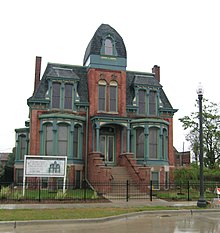
In April 2008, the city unveiled a $300 million stimulus plan to create jobs and revitalize neighborhoods, financed by city bonds and paid for by earmarking about 15% of the wagering tax.[58] The city's plans for revitalization with the Next Detroit Neighborhood Initiative, a 501 (c)(3) organization, include 7-Mile/Livernois, Brightmoor, East English Village, Grand River/Greenfield, North-End, and Osborn.[58][59] Private organizations have pledged substantial funding to neighborhood revitalization efforts.[60][61]
A new master plan draft prepared in 2004 has the city composed of ten clusters of neighborhood areas and commercial districts. The plan revealed that Detroit has many growing neighborhoods with youth population increases of greater than ten percent within each cluster, while also showing that larger youth population losses were focused in certain areas, providing support for the concept of focused redevelopment and planning.[62] The city issued a Strategic Master Plan in 2006.[63] In addition to increased business investment, the city's revitalization has been focused on retaining young professionals. The city has cleared a 1,200-acre (490 ha) section of land to initiate the Far Eastside Plan for new neighborhood construction and revitalizations.[64][65] A 2009 parcel survey found 86 percent of the city's homes to be in good condition, with another 9% needing only minor repairs.[66] The survey found 33,527 or 10% of the city's housing to be unoccupied, but recommended that only one percent or 3,480 of the city's housing units needed to be demolished.[66] About 3,000 of these residential structures were cleared away in 2010.[67][68][69][70][71]
Immigrants have successfully contributed to the city's neighborhood revitalization, especially in southwest Detroit.[72] This area has experienced a thriving economy in recent years, as evidenced by new housing, increased business openings and the recently opened Mexicantown International Welcome Center.[73]
Lafayette Park is a revitalized neighborhood on the city's east side, part of the Mies van der Rohe Residential District listed in the National Register of Historic Places.[74] The 78-acre (32 ha) urban renewal project was originally called the Gratiot Park Development. Planned by van der Rohe, Ludwig Hilberseimer and Alfred Caldwell, it includes a landscaped, 19-acre (7.7 ha) park with no through traffic, in which these and other low-rise apartment buildings are situated. Churches, schools, parks, theaters, and retail businesses have helped to anchor neighborhoods in the city.[75]
Partial list of residential developments
[edit]
Old buildings in the city are being transformed into lofts, condominiums, and high-rise residential apartment units at an accelerated pace along with new Formstone and brick rowhouse construction.
- Alden Park Towers (2014).
- Riverfront Towers (2014).
- Town Residences (2014)
- The Albert (2014)
- David Whitney Building, hotel & apartments (2014)
- David Broderick Tower (2012)
- Westin Book-Cadillac, hotel & condominiums (2008)
- 1001 Woodward, luxury condominiums (2007)[76]
Many more projects are in the process of planning/rendering, and this is all helping bring back more residents to the downtown area.[77]
Buildings
[edit]Significant renovations are being undertaken by luxury hotel developers downtown such as Hilton, Westin, Double Tree, and Four Seasons. Some buildings are being redeveloped into high-rise condominiums and residential lofts. These projects are attracting new investment in corporate headquarters, offices, and retail.[78][79] The city has demolished many unused buildings in order to make way for new development. Highlights of some of the significant renovated buildings and vacant structures are noted below:
Renovated structures
[edit]| Name | Built | Architect | Location | Notes | Image |
|---|---|---|---|---|---|
| Aloft Detroit at The David Whitney | 1914 | Daniel Burnham | 1553 Woodward Avenue | Completed in December 2014 as an Aloft hotel/residential high-rise. | 
|
| Argonaut Building | 1930 | Albert Kahn | 485 W. Milwaukee Ave. | General Motors donated the building to the College for Creative Studies. Redeveloped in 2009. | 
|
| Belle Isle Aquarium | 1904 | Albert Kahn | Conservatory Drive and Inselhrue Ave. | Reopened September 2012.[80] | 
|
| Book Tower | 1916/1926 | Louis Kamper | 1265 Washington Boulevard | The Book Tower was power washed in 2017 for the first time in decades. Bedrock bought the building in 2015, and the renovation included residences, offices, retail, and a high-end hotel. Stabilization, cleaning, and restoration work had been underway. Completed in 2023.[81] | 
|
| Cadillac Place | 1923 | Albert Kahn | 3044 W. Grand Blvd. | Redeveloped in 2002 as a state office complex. | 
|
| David Broderick Tower | 1928 | Paul and Louis Kamper | 10 Witherell St. | Redeveloped in 2012 as a residential high-rise. | 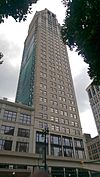
|
| David Stott Building | 1929 | John M. Donaldson | 1150 Griswold Street | Bedrock acquired the Capitol Park Art Deco skyscraper in 2015, after a Chinese investment group neglected the building. Work had been underway for a while to restore it back to its original beauty. Completed in 2018.[81] | 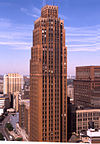
|
| Eddystone Apartments | 1924 | Louis Kamper | 100 Sproat Street | One of three hotels built for Lew Tuller. Renovated as part of the Little Caesars Arena development. Completed in 2022.[82] | 
|
| Farwell Building | 1915 | Harrie Bonnah | 1249 Griswold Street | Owned by Motown Construction, owners of the David Broderick Tower. Bought by Karp & Associates LLC, now slated for a mixed-use renovation with financing secured in 2015. Completed in August 2019.[83] | 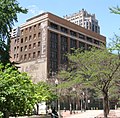
|
| Element Detroit at the Metropolitan | 1925 | Weston and Ellington | 33 John R. Street | The building was originally built to house wholesale and retail jewelry businesses. The Roxbury Group, who led the renovation of the David Whitney Building, is also renovating the long-vacant Metropolitan Building. It will reopen as the Element Hotel, with "110 light-filled rooms and an atmosphere designed to fuel a life in balance and on the move." Completed in December 2018.[81] | 
|
| Ford Piquette Avenue Plant | 1904 | Field, Hinchman & Smith | 461 Piquette Ave. | Second American factory run by Ford Motor Company. Birthplace of the Ford Model T. Museum as of 2001. | 
|
| Fort Shelby Hotel | 1916/1927 | Albert Kahn | 525 W. Lafayette Blvd. | Renovated in 2008 as a DoubleTree hotel. | 
|
| Harmonie Centre | 1905 | Raseman & Fischer | 1308 Broadway | Also known as Breitmeyer-Tobin Building. It is part of the Broadway Avenue Historic District. | 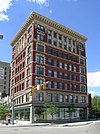
|
| Kales Building | 1914 | Albert Kahn | 76 W. Adams St. | Redeveloped in 2004 as a residential high-rise with retail. It is part of the Park Avenue Historic District. | 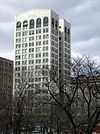
|
| Neighborhood Service Organization Building | 1929 | 882 Oakman Blvd. | Redeveloped as the Neighborhood Service Organization (NSO) Building. It was formerly the Michigan Bell and Western Electric Warehouse. Total investment estimated at $50M.[84] | 
| |
| Michigan Central | 1913 | Warren & Wetmore | 2405 West Vernor Highway | Ford Motor Company purchased the building in 2018. Ford will use MCS as the centerpiece to its mobility-focused Corktown campus. Completed in 2023. Listed on the National Register of Historic Places. Located near the Ambassador Bridge and the West Vernor-Junction Historic District.[81] | 
|
| Newlab @ Michigan Central | Albert Kahn | 2231 Dalzelle Street | Former Detroit Public Schools book depository. Ford Motor Company purchased the building in 2018. Completed in 2023. | 
| |
| Park Avenue House | 1924 | Louis Kamper | 2305 Park Ave. | Also known as the Royal Palm. It is part of the Park Avenue Historic District. The Towne Pump Tavern is located on the ground floor. | 
|
| The Press/321 | 1925 | Albert Kahn | 321 West Lafayette Street | Bedrock purchased the old Detroit Free Press Building in 2016, which had been vacant since 2001. Construction on the $69 million redevelopment had been underway downtown. Completed in 2021.[81] | 
|
| River Place | 1891 | Donaldson and Meier, Albert Kahn, and Smith, Hinchman and Grylls | Former Parke-Davis pharmaceutical plant, redeveloped as a mixed use residential complex of buildings. | 
| |
| Riverwalk Hotel | 1902 | Donaldson and Meier, Albert Kahn | 1000 River Place | Former Parke-Davis research laboratory, redeveloped as a hotel and residence. | 
|
| Shinola Hotel | 1915 | Baxter and O'Dell & Halpin | 1400 Woodward Avenue | Bedrock and Shinola are redeveloping half a block of lower Woodward into the Shinola Hotel, which will have eight floors with 130 rooms and 16,000 square feet of retail and restaurant space. Two smaller buildings have been demoed in order to rebuild and connect the structures. Completed in December 2018.[81] | |
| The Siren Hotel | 1926 | Robert Finn | 1509 Broadway Street | High-rise building in downtown which stands at 14 floors. The building at one time held offices originally serving the Wurlitzer Organ Co. It was designed in the renaissance revival architectural style and stands next to the Metropolitan Building. It reopened as The Siren Hotel and was completed in December 2017.[85][86][87][88] | |
| Vinton Building | 1916 | Albert Kahn | 600 Woodward Ave. | Redeveloped in 2007 as a residential high-rise. | 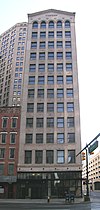
|
| Wayne County Building | 1902 | John and Arthur Scott | 600 Randolph Street | A group of New York investors purchased the Old Wayne County Building, which the county sold in July 2014. Exterior work has been happening for the past year, and the owners have been looking for a single tenant to fill the Beaux Arts structure downtown. Completed in 2018.[81] | 
|
| Westin Book-Cadillac Hotel | 1924 | Louis Kamper | 1114 Washington Blvd. | Renovated in 2008 as a Westin hotel. | 
|
| The Whittier | 1922 | Charles N. Agree | 415 Burns Dr. | Redeveloped in 2003 as a residential high-rise. | 
|
Vacant structures
[edit]| Name | Built | Architect | Location | Notes | Image | |
|---|---|---|---|---|---|---|
| The Detroit Leland | 1927 | Rapp & Rapp | 400 Bagley Street | Developers started work on a $120 million renovation of the Leland Hotel in 2023. The building will offer 340 rental apartments. Completion is scheduled for 2025.[81][89] | 
| |
| Detroit Life Building | 1923 | Arnold & Shreve | 2210 Park Avenue | Olympia announced that exterior work had started on this long-vacant building. Kramer Design Group is leading the design of this $17 million redevelopment into 32,000 square feet of office and 6,000 square feet of retail.[90] | 
| |
| Film Exchange Building | 1926 | C. Howard Crane | 2310 Cass Avenue | Distributed films to Detroit's theatres. Detail shown. | 
| |
| Fisher Body Plant 21 | 1919 | Albert Kahn | 700 Piquette Avenue | Former automobile factory, then a Carter Color in the 1990s. A long-empty Detroit auto body factory, Fisher Body Plant No. 21, would be transformed into more than 400 apartments plus retail space under a redevelopment plan unveiled Monday, March 7, 2022 by the developers and city officials. The $134 million project, called Fisher 21 Lofts, is to go for site approvals late spring 2022 and could get underway late 2023 for a 2025 completion date. | 
| |
| Grande Ballroom | 1928 | Charles N. Agree | 8952 Grand River Avenue | Has served as a rock concert venue. | 
| |
| Herman Kiefer Hospital | 1928 | George Mason | 1151 Taylor Street | Led by New York developer and architect Ron Castellano, the redevelopment covers 18 acres of the former hospital complex and could cost $100 million. Early plans could include a hotel and a skate park, and altogether, it could take up to eight years to complete.[81] | ||
| Lee Plaza Hotel / Apartments | 1928–1929 | Charles Noble | 2240 West Grand Boulevard | The city of Detroit plans to sell Lee Plaza to a joint venture that will redevelop the historic building into 180 residential units, and retail. The redevelopment will be a joint effort by Detroit-based Roxbury Group and Ethos Development Partners, who bought the property from the city in 2019 for $350,000. The project's initial $59 million phase is to start next year and finish in 2024 with the creation of 117 new affordable residences for income-qualified seniors on floors 2 through 10. A second $20 million phase would create 60 to 70 market-rate apartments on floors 11 through 16 with an anticipated 2025 completion.[91] | 
| |
| National Theatre | 1911 | Albert Kahn, Ernest Wilby | 118 Monroe Street | Surviving historic structure on the Monroe Block has Baroque-Beaux Arts-Moorish style. Theatre seating capacity was 800.[92] | 
| |
| Packard Automotive Plant | 1911 | Albert Kahn | East Grand Boulevard & Concord Street | Pablo Palazuelo purchased the plant in 2013. Demolition is scheduled for 2023.[93] | 
|
|
| United Artists Theatre Building | 1928 | C. Howard Crane | 150 Bagley Street | Possibility for redevelopment by Ilitch Holdings. Theatre seating capacity is 2,070. | 
| |
| Vanity Ballroom | 1926 | Charles N. Agree | 1024 Newport Street | Has served as a rock concert venue. | 
| |
| Women's City Club Building | 1924 | William B. Stratton | 2110 Park Avenue | Olympia announced the rehab of the building in 2018. Kramer Design Group will lead the $25 million renovation of this building, which will have 47,000 square feet of office space and 10,000 square feet of retail space.[90] | 
|
Major structures demolished
[edit]| Name | Built | Demolished | Architect | Location | Notes |
|---|---|---|---|---|---|
| Park Avenue Hotel | 1924 | 2015 | Louis Kamper | 2643 Park Avenue | One of three hotels built for Lew Tuller. |
| Hotel Charlevoix | 1905 | 2013 | William S. Joy | 2029 Park Avenue | Beaux-Arts styled brick residential building.[94][95][96] |
| Lafayette Building | 1923 | 2010 | Charles Howard Crane | 144 West Lafayette Boulevard | Italian Renaissance style architecture. |
See also
[edit]References
[edit]- ^ Detroit News Staff (September 29, 2001). How the Renaissance Center changed the landscape of Detroit Archived January 2, 2013, at archive.today Michigan History, The Detroit News. Retrieved on May 3, 2009.
- ^ Portman, John and Jonathan Barnett (1976). The Architect as Developer. McGraw Hill. ISBN 0-07-050536-5.
- ^ Sharoff, Robert (2005). American City: Detroit Architecture. Wayne State University Press. ISBN 0-8143-3270-6.
- ^ McWhirter, Cameron and Darren A. Nichols (December 13, 2002). "Hurdles will test riverfront vision", Detroit News.
- ^ Williams, Corey (9-13-2007).Detroit casinos deal city urban renewal. Retrieved on December 31, 2008.
- ^ "The Detroit RiverFront Conservancy - East Riverfront". Archived from the original on March 23, 2013. Retrieved March 13, 2013.
- ^ "Detroit Riverfront Conservancy". Detroitriverfront.org. Retrieved January 27, 2020.
- ^ History | Business Leaders For Michigan
- ^ "BUSINESS LEADERS FOR MICHIGAN | Follow the Money". Archived from the original on February 15, 2012. Retrieved March 13, 2013.
- ^ Michigan Turnaround Plan
- ^ "Building a New Michigan Detroit - Business Leaders for Michigan". Michiganturnaroundplan.com. Retrieved January 27, 2020.
- ^ Detroit Renaissance accomplishments. Retrieved on July 24, 2007.
- ^ CIRE Magazine :: Federal Historic Tax Credit Aids Adaptive Reuse Developers
- ^ National Historic Preservation Act of 1966 Archived January 29, 2011, at the Wayback Machine, Public Law 102-575, National Register of Historic Places, Official site. Retrieved May 12, 2010.
- ^ http://www.michbar.org/journal/pdf/pdf4article1665.pdf [bare URL PDF]
- ^ Bailey, Ruby L (August 22, 2007). "The D is a draw: Most suburbanites are repeat visitors", Detroit Free Press. New Detroit Free Press-Local 4 poll conducted by Selzer and Co., finds, "nearly two-thirds of residents of suburban Wayne, Oakland, and Macomb counties say they at least occasionally dine, attend cultural events or take in professional games in Detroit." Retrieved on August 22, 2007.
- ^ Mercer, Tenisha (October 19, 2005)GM's RenCen renovation attracts new business back. Detroit News. Retrieved on July 24, 2007.
- ^ Detroit News Editorial (December 13, 2002). At Last, Sensible Dream for Detroit's Riverfront. Detroit News.
- ^ Concrete Monthly (October 2005)Lafarge's new cement terminal is an important part of Detroit's revitalization Archived June 28, 2009, at the Wayback Machine. Retrieved on July 24, 2007.
- ^ Crain's Detroit Business (October 4, 2007)Bank of America commits $25 billion for community development in Michigan. Metro Mode Media. Retrieved on September 6, 2008.
- ^ Schroeder, Robert (July 30, 2010).Obama says U.S. auto industry on rebound. Wall Street Journal. Retrieved on December 28, 2010.
- ^ GM posts profit, CEO Whitacre to retire.CNN Money. Retrieved on December 28, 2010.
- ^ Cwiek, Sarah (November 30, 2010).New study shows strong economic recovery in Metro Detroit Archived May 11, 2011, at the Wayback Machine. NPR Michigan. Retrieved December 28, 2010.
- ^ Alan Berube and Philipp Rode: "Global MetroMonitor: The Path to Economic Recovery", The Brookings Institution and London School of Economics and Political Science, November 30, 2010.
- ^ University of Michigan-Dearborn. "Detroit Metropolitan Wayne County Airport: 2006 Economic Impact Study." 2006.
- ^ U.S. Bureau of Transportation Statistics. http://www.transtats.bts.gov/airports.asp?pn=1
- ^ Federal Aviation Administration. www.apo.data.faa.gov/main/taf.asp
- ^ Mayor's Office of Targeted Business Development | City of Detroit | www.detroitmi.gov
- ^ Misbtdc
- ^ a b c d "Detroit Economic Growth Corporation". DEGC. Retrieved January 27, 2020.
- ^ Mayor's Office of Neighborhood Commercial Revitalization | City of Detroit | www.detroitmi.gov
- ^ "Michigan Works! Association". Michiganworks.org. January 15, 2020.
- ^ Evan Klonsky: 5 Reasons To Start A Business In Detroit, Inc. - Small Business Resources for the Entrepreneur, October 7, 2010.
- ^ Glasmeier, McCluskey: U.S. Auto Parts Production: An Analysis of the Organization and Location of a Changing Industry, Economic Geography, 1987.
- ^ Nancy Cappola: We Are North America's Innovation Corridor!, Tech Town - Wayne State University Research and Technology Park, March 29, 2010.
- ^ Sharoff, Robert (January 30, 2005)National Perspectives: Waves of Renovations Helping Downtown Detroit. New York Times. Retrieved on July 24, 2007.
- ^ City of Detroit General Fund -Percent Change in major Revenue Sources Archived September 27, 2007, at the Wayback Machine. City of Detroit 2006-07 Budget
- ^ A 140-Acre Forest Is About to Materialize in the Middle of Detroit Sarah Goodyear October 25, 2013 Atlantic Cities
- ^ Detroit: "Farm City"
- ^ Hantz Farms | Introduction
- ^ "Detroit's $210M street lighting plan OK'd by bankruptcy judge; creditors' concerns dismissed | Detroit Free Press | freep.com". Archived from the original on March 6, 2014. Retrieved March 7, 2014.
- ^ "Detroit lighting board approves LED lights". Crainsdetroit.com. January 29, 2014.
- ^ Detroit lighting authority to borrow $185 million, expand streetlight upgrades
- ^ Shea, Bill (July 20, 2014). "Detroit Rink City: Ilitches' Grand Plan to Supersize the Entertainment District". Crain's Detroit Business. Retrieved July 25, 2014.
- ^ "Detroit streetcar breaks ground". Railway Gazette. July 28, 2014. Archived from the original on August 9, 2014. Retrieved May 4, 2015.
- ^ "Construction Starts on Detroit Rail". The Mining Journal. Marquette, MI. Associated Press. July 28, 2014. p. 5A.
- ^ "Wayne State University IBio - The Integrative Biosciences Center".
- ^ "Wayne State dedicates new $93 million biosciences center". July 2, 2020.
- ^ Gallagher, John (February 15, 2015). "M-1 Rail's Tech Center Under Construction". Detroit Free Press. Retrieved February 15, 2015.
- ^ "New Home of Detroit's streetcar line unveiled".
- ^ "Humane Society building space for animals in Detroit".
- ^ "MHS opens new Detroit Animal Care Campus".
- ^ "MHS Dresner Foundation Animal Care Campus".
- ^ "Henry Ford unveils plans for a multi-million dollar cancer center".
- ^ "Largest Individual Gift in Henry Ford Hospital History".
- ^ "City seeks $30 million federal development grant for Brewster-Douglass and Eastern Market sites". January 29, 2016.
- ^ Pfeffer, Jaime (September 12, 2006).Falling for Brush Park.Model D Media. Retrieved on September 26, 2009.
- ^ a b Next Detroit Archived May 2, 2008, at the Wayback Machine. City of Detroit. Retrieved on December 31, 2008.
- ^ Bello, Marisol, (March 13, 2007)Reclaiming the neighborhood series Detroit Free Press. Retrieved on July 24, 2007.
- ^ Community Development Archived February 4, 2008, at the Wayback Machine.DEGA. Retrieved on December 31, 2008.
- ^ Detroit Neighborhood Fund Archived February 6, 2009, at the Wayback Machine.Community Foundation for Southeast Michigan. Retrieved December 31, 2008.
- ^ City of Detroit, 2004 Master Plan Draft, p. 4. Retrieved on August 11, 2008.
- ^ City of Detroit, Strategic Master Plan. Retrieved on August 11, 2008.
- ^ Rose, Judy (May 11, 2003).Detroit to revive 1 neighborhood at a time.Chicago Tribune. Retrieved November 29, 2011.
- ^ Morice, Zach (September 21, 2007).Planning community in fallow fields Archived July 23, 2011, at the Wayback Machine.American Institute of Architects. Retrieved on June 24, 2009.
- ^ a b Detroit Parcel Survey. Retrieved on June 24, 2010.
- ^ Crews to start tearing down derelict buildings in Detroit | freep.com | Detroit Free Press
- ^ Kavanaugh, Kelli B. (March 2, 2010).Intensive property survey captures state of Detroit housing, vacancy. Model D. Retrieved November 3, 2011.
- ^ Associated Press (February 10, 2010).Survey.Mlive.com. Retrieved November 27, 2011.
- ^ Gallagher, John (February 20, 2010). "Housing in Detroit". Detroit Free Press. pp. 1A, 9A. Retrieved November 27, 2011.
95% of Detroit homes are deemed suitable for occupancy, 86% of Detroit's single family homes are in good condition, 9% are generally in need of minor repair
- ^ "Detroit Residential Parcel Survey". D-acis.org. February 22, 2010.
- ^ Rodriguez, Cindy (May 23, 2007).A Detroit success story: Can-do spirit revives southwest neighborhood. Detroit News. teamowners313.wordpress.com. Retrieved on December 31, 2008.
- ^ Williams, Corey (February 28, 2008).New Latino Wave Helps Revitalize Detroit. USA Today. Retrieved on December 31, 2008
- ^ Vitullo-Martin, Julio, (December 22, 2007). The Biggest Mies Collection: His Lafayette Park residential development thrives in Detroit.The Wall Street Journal.Retrieved on December 31, 2008.
- ^ Cityscape Detroit - see neighborhoods Archived December 15, 2013, at the Wayback Machine
- ^ 1001 Woodward Archived July 8, 2007, at the Wayback Machine. Retrieved July 25, 2007.
- ^ Tweh, Bodeya and Jewel Gopwani (June 14, 2007). 8 Mile Woodward mall plan gets a boost. Detroit Free Press.
- ^ The world is coming, see the change Archived June 13, 2008, at the Wayback Machine. City of Detroit Partnership. Retrieved on June 23, 2009.
- ^ Howes, Daniel (November 13, 2007).Quicken to move to Detroit. The Detroit News. Retrieved on June 23, 2009.
- ^ "A landmark reborn: Belle Isle Aquarium reopens to thousands | Metro Detroit | Detroit Free Press | freep.com". Archived from the original on September 20, 2012. Retrieved March 4, 2013.
- ^ a b c d e f g h i "Mapping the 12 biggest redevelopments underway in Detroit". Detroit.curbed.com. December 26, 2019.
- ^ Aguilar, Louis (March 26, 2015). "Ilitches set affordable housing goal in epic plans". The Detroit News. Retrieved March 30, 2015.
- ^ Gallagher, John (March 18, 2015). "Detroit archdiocese dedicates its new home in Capitol Park district". The Detroit Free Press. Retrieved March 30, 2015.
- ^ "Bell Building set for renovation," Staff report, November 29, 2009, The Michigan Citizen.
- ^ Wurlitzer Building at HistoricDetroit.org
- ^ Pinho, Kirk (May 18, 2015). "Wurlitzer Building sells for $1.4 million; boutique hotel, $20 million redevelopment planned". Crain's Detroit Business. Retrieved February 1, 2016.
- ^ Wurlitzer Building at Emporis.com[usurped]
- ^ SkyscraperPage.com's Profile on the Wurlitzer Building
- ^ "Leland House to become 340 rental apartments". Detroit Free Press. Retrieved January 27, 2020.
- ^ a b "Olympia announces more new construction, rehabs in arena district". Detroit.curbed.com. April 30, 2018.
- ^ "Detroit to sell Lee Plaza for 180-unit redevelopment". February 14, 2019.
- ^ Hyde, Charles (May–June 1991).Demolition by Neglect: The Failure to Save the Monroe Block Archived January 14, 2008, at the Wayback Machine.Michigan History Magazine.Retrieved on June 23, 2009.
- ^ "The Packard Plant breaks ground on first phase of massive redevelopment". Detroit.curbed.com. May 16, 2017.
- ^ Hotel Charlevoix, Detroit1701.org, Retrieved February 23, 2010
- ^ Charlevoix Building details at Emporis.com[usurped]
- ^ SkyscraperPage.com's Profile on Charlevoix Building Building
Further reading
[edit]- Anjaneyulu, Logan (2003). Building Rehabilitation: A Promising Tool for Urban Revitalization in Detroit, Michigan (Thesis). Michigan State University, Construction Management Program.
- Fisher, Dale (2003). Building Michigan: A Tribute to Michigan's Construction Industry. Grass Lake, MI: Eyry of the Eagle Publishing. ISBN 1-891143-24-7.
- Fogelman, Randall (2004). Detroit's New Center. Arcadia. ISBN 0-7385-3271-1.
- Ford, Larry R. (2003). America's New Downtowns: Revitalization or Reinvention. Johns Hopkins University Press. ISBN 978-0-8018-7163-4.
- Greenberg, Michael R. (1999). Restoring America's Neighborhoods: How local people make a difference. Rutgers University Press. ISBN 0-8135-2712-0.
- Portman, John and Jonathan Barnett (1976). The Architect as Developer. McGraw Hill. ISBN 0-07-050536-5.
